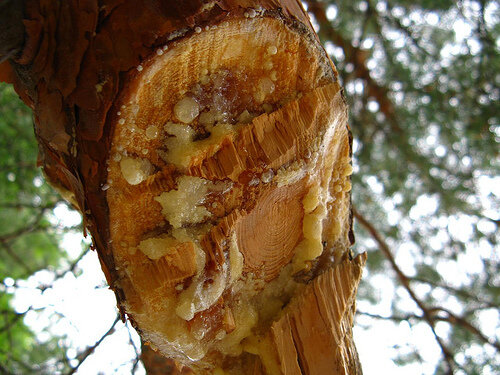I was having some difficulty sleeping the other night and decided to try and work my way through some recorded shows on the DVR. One of the recordings was the Mountain Men series. In this particular episode, one of the guys (Tom Oar) is building a traditional dugout canoe for a museum and accidentally puts a hole in the boat.
What happened next fascinated me.
He and his brother proceeded to make a traditional product called a pine pitch patch. Tom even dictated the formula for the camera and viewers.
65% Pine Pitch
15% Dried Buffalo (Bison) Dung
15% Cooked Egg Shells
5% Beeswax
Let’s breakdown the ingredients in Tom’s recipe. All of the ingredients carry waterproofing qualities but two (pine pitch and beeswax) also work as the adhesive.
Pine Pitch
First things first… what is pine pitch?
Well, anyone that grew up where I did (completely surrounded by pine trees) can tell you that pitch is basically the crystallized sap. It’s not in a honey-like liquid state and it hasn’t hardened into resin yet. It’s somewhere in-between. Pitch is still somewhat malleable and makes a great fire starter.
Here’s an article that discuss the differences between sap, pitch, and resin. The above image is from that article.
Buffalo (Bison) Dung
Now, there aren’t any bison near me except in the zoo. I do happen to know someone that works there though so I imagine I could get my hands on some. In this scenario, I imagine dried cow or horse dung would work too. The purpose behind the dung is waterproofing. A mixture of mud and dung was traditionally used on the floors and walls of the first homes and is still used in places like India. Weird, but ok. Doesn’t seem very sanitary though. I think I’ll stick with Tyvek!
Here’s an article about the many uses of cow dung.
Egg Shells
The egg shells in Tom’s recipe refers to egg shell powder and not chunks of cooked shells. Basically, save the egg shells from scrambled eggs, hard boiled eggs, baking, or from any other purpose where eggs were used. Then:
Wash the shells out under warm running water to remove any remaining egg parts and membrane.
Boil the shells for two minutes.
Place the boiled shells on a parchment paper covered cooking sheet and bake at 225-degrees for 45 minutes to remove all moisture.
Place the cooked shells in a high-speed blender and grind them down into a fine powder.
The egg shells in Tom’s recipe is another ingredient used as waterproofing. It also helps the patch maintain some resiliency and durability as the canoe encounters rough shores and rocky river bottoms.
Beeswax
This ingredient is yet another waterproofing material but also, along with the pine pitch, helps as an adhesive. There are thousands of uses for beeswax. Far too many to mention here.
Now, from there, Tom and his brother combined the ingredients, heated them into a liquid like paste, then spread the pine pitch over the hole, inside and out. Once there was a layer of the pine pitch goop around the hole on the outside of the canoe, they then applied a piece of antelope rawhide and covered that with the remaining pine pitch patch material.
Now you know how to repair your traditional dugout canoe with traditional materials.
Fascinating.
